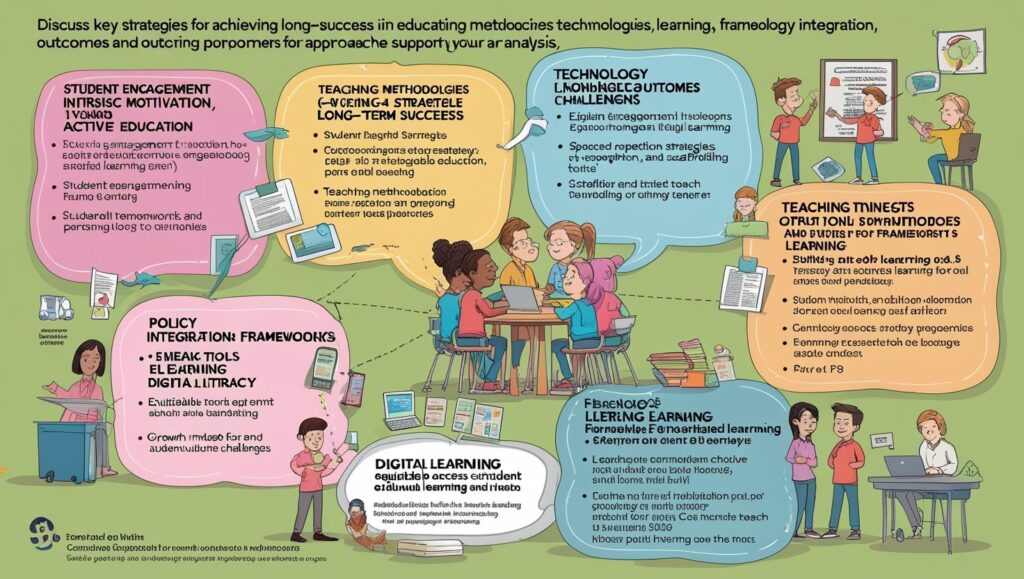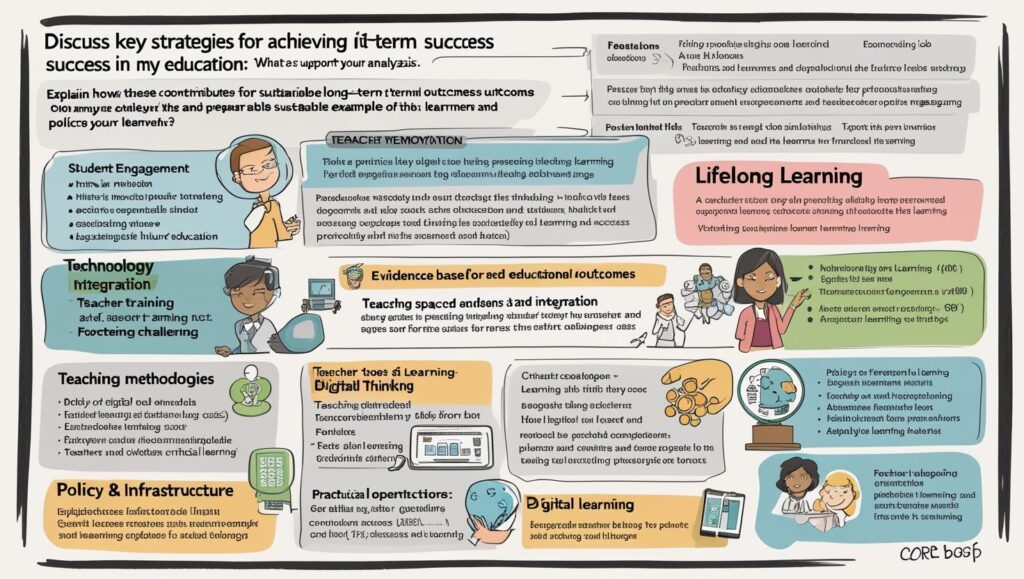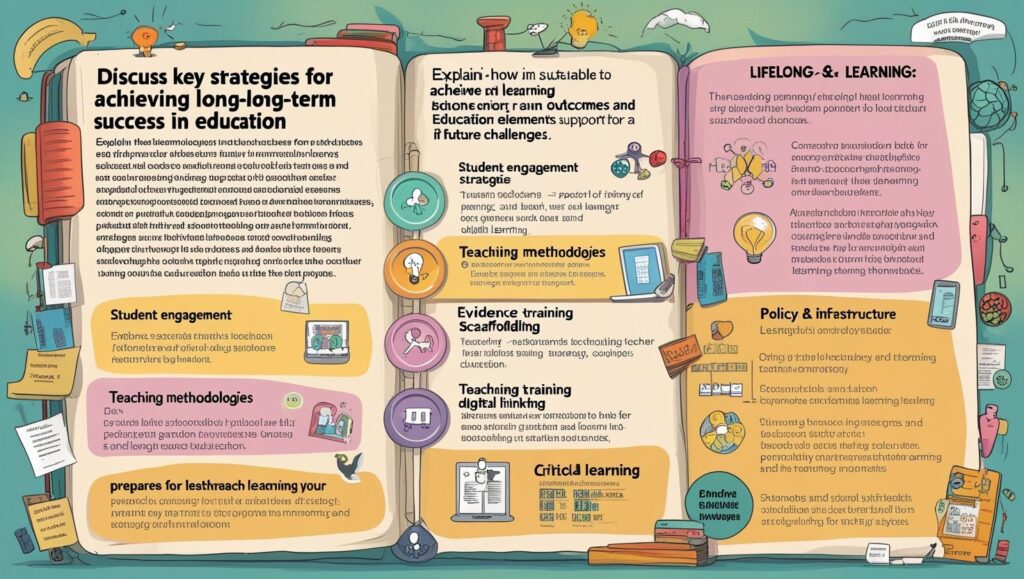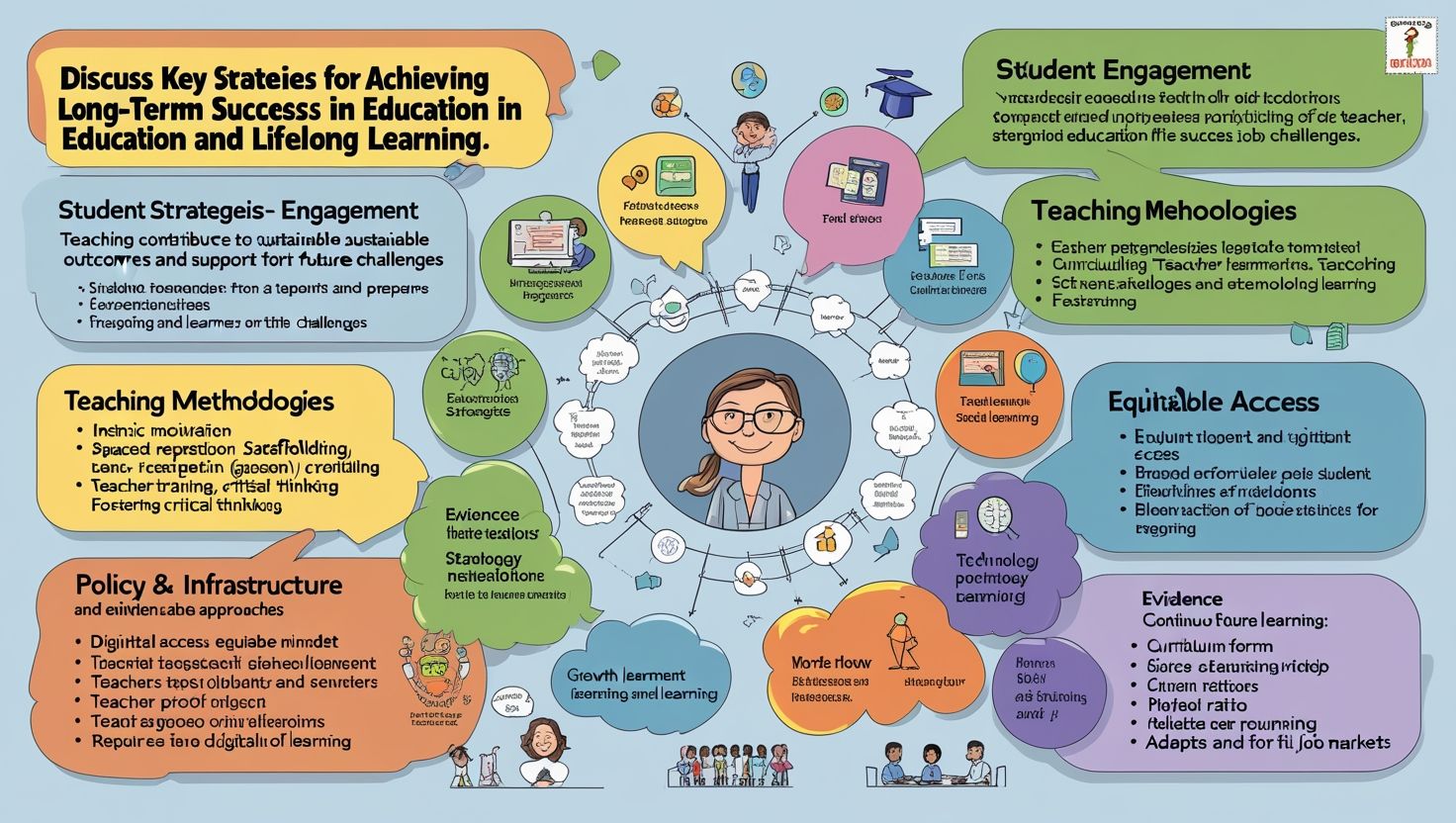Introduction
Strategies for Long-Term Success in Education, Education serves as the foundation for personal development and societal progress, transforming individuals into informed, skilled, and responsible citizens. However, achieving long-term success in education goes beyond short-term academic performance—it requires a strategic, adaptable, and sustained approach. In today’s rapidly changing world, students, educators, and policymakers must embrace innovative strategies to create a resilient and future-ready education system.
This article explores comprehensive strategies for ensuring sustainable success in education, focusing on key areas such as student engagement, teaching methodologies, technology integration, policy development, and lifelong learning. By addressing these aspects holistically, we can cultivate an environment where learners not only excel academically but also develop critical life skills. The ultimate goal is to prepare students for an unpredictable future, equipping them with the knowledge, adaptability, and creativity needed to thrive in evolving job markets and societal landscapes.
1. Fostering Student Engagement and Motivation
A. Cultivating Intrinsic Motivation
Intrinsic motivation—where students are driven by curiosity and personal growth rather than external rewards—is essential for deep and lasting learning. Educators can nurture this by designing lessons that spark curiosity, such as inquiry-based activities where students explore questions and solve real-world problems. Connecting academic concepts to practical applications (e.g., using math in budgeting or science in environmental projects) makes learning more meaningful. Additionally, giving students autonomy in choosing research topics or project formats fosters ownership of their education, increasing engagement and retention.
B. Active Learning Techniques
Traditional lecture-based teaching often leads to passive absorption of information, which can result in disengagement and poor retention. Active learning strategies, such as group discussions, case studies, and hands-on experiments, encourage students to think critically and apply knowledge. Collaborative projects, peer teaching, and problem-solving tasks further enhance comprehension by requiring students to engage with material dynamically. Research shows that active learning improves academic performance and long-term memory retention compared to passive methods.
C. Personalized Learning Approaches
Every student has unique learning preferences, strengths, and challenges. Personalized learning tailors instruction to individual needs through adaptive technologies (e.g., AI-driven platforms that adjust difficulty levels) and differentiated teaching strategies. Regular one-on-one feedback sessions help educators identify gaps and provide targeted support. By recognizing diverse learning styles—whether visual, auditory, or kinesthetic—teachers can create inclusive classrooms where all students thrive.

2. Enhancing Teaching Methodologies
A. Evidence-Based Instructional Strategies
Effective teaching relies on research-backed methods that maximize learning efficiency. Spaced repetition (reviewing material at increasing intervals) combats the “forgetting curve,” while interleaved practice (mixing different subjects or skills) strengthens cognitive flexibility. Scaffolding—breaking complex tasks into manageable steps with gradual independence—helps students master challenging concepts. These techniques, grounded in cognitive science, lead to deeper understanding and long-term retention.
B. Professional Development for Educators
Teachers must stay updated with evolving pedagogical trends through continuous professional development. Workshops on innovative teaching methods (e.g., flipped classrooms, gamification) and peer collaboration programs foster skill-sharing. Mentorship initiatives pair experienced educators with newcomers to enhance classroom effectiveness. Encouraging teachers to engage with academic research ensures they apply the latest evidence-based strategies in their instruction.
C. Encouraging Critical Thinking and Creativity
Rote memorization fails to prepare students for real-world challenges. Schools should prioritize problem-based learning, where students tackle open-ended questions, and Socratic seminars, which promote analytical dialogue. Creative projects—such as designing prototypes or composing multimedia presentations—allow students to apply knowledge innovatively. By valuing creativity as much as academic rigor, educators cultivate adaptable, forward-thinking learners.
3. Leveraging Technology in Education
A. Digital Learning Tools
Technology revolutionizes education by making learning interactive and accessible. Platforms like Kahoot! and Nearpod engage students through gamified quizzes and virtual collaboration. Massive Open Online Courses (MOOCs) from Coursera and edX provide free access to university-level content. AI-driven adaptive learning systems (e.g., DreamBox for math) personalize instruction by adjusting to each student’s pace, ensuring no one is left behind.
B. Blended and Hybrid Learning Models
Combining in-person and online instruction offers flexibility for diverse learners. Hybrid models benefit remote students, those requiring self-paced study, and schools with limited resources. For example, flipped classrooms allow students to watch lectures at home and use class time for discussions, maximizing teacher-student interaction. Such models also prepare students for digital workplaces by familiarizing them with virtual collaboration tools.
C. Ensuring Digital Literacy
In a tech-driven world, students must master online research skills, cybersecurity basics, and digital ethics. Schools should integrate courses on evaluating online sources, preventing plagiarism, and using productivity tools (e.g., Google Workspace). By embedding digital literacy into curricula, educators empower students to navigate the internet responsibly and efficiently.

4. Building Strong Educational Policies and Infrastructure
A. Equitable Access to Quality Education
Long-term success requires addressing disparities by:
- Funding underprivileged schools.
- Providing scholarships and financial aid.
- Ensuring rural and urban schools have equal resources.
B. Curriculum Reform for Future Skills
Education systems must evolve to teach:
- STEM (Science, Technology, Engineering, Math) for technological advancement.
- Soft Skills like communication, teamwork, and emotional intelligence.
- Financial and Civic Literacy for real-world preparedness.
C. Stronger Teacher-Student Ratios
Smaller class sizes allow for:
- More individualized attention.
- Better classroom management.
- Enhanced student-teacher relationships.
5. Promoting Lifelong Learning and Adaptability
A. Encouraging Continuous Education
Learning shouldn’t stop at graduation. Strategies include:
- Promoting adult education programs.
- Encouraging professional certifications.
- Supporting online upskilling courses.
B. Developing a Growth Mindset
Students should embrace challenges and view failures as learning opportunities. Educators can reinforce this by:
- Praising effort over innate ability.
- Teaching resilience and problem-solving.
- Encouraging self-reflection and goal-setting.
C. Preparing for Future Job Markets
With automation and AI changing industries, students must:
- Learn adaptable skills (e.g., coding, data analysis).
- Stay informed about emerging career trends.
- Engage in internships and apprenticeships.
6. Strengthening Parental and Community Involvement
A. Parental Engagement in Learning
Parents play a crucial role by:
- Creating a supportive home learning environment.
- Monitoring academic progress.
- Encouraging reading and intellectual discussions.
B. Community-Based Educational Programs
Local organizations can support education through:
- After-school tutoring and mentorship.
- Scholarship funds and career guidance workshops.
- Partnerships with businesses for real-world learning experiences.

7. Assessing and Improving Educational Outcomes
A. Regular and Meaningful Assessments
Instead of relying solely on standardized tests, schools should use:
- Formative assessments for ongoing feedback.
- Portfolio-based evaluations.
- Competency-based grading.
B. Data-Driven Decision Making
Schools should analyze student performance data to:
- Identify learning gaps.
- Adjust teaching strategies.
- Allocate resources effectively.
C. Continuous Improvement Cycles
Educational institutions must adopt a culture of improvement by:
- Regularly reviewing curriculum effectiveness.
- Incorporating student and teacher feedback.
- Benchmarking against global best practices.
Conclusion
Achieving long-term success in education is a multifaceted endeavor that requires collaboration among students, educators, policymakers, and communities. By fostering engagement, leveraging technology, reforming policies, and promoting lifelong learning, we can build an education system that prepares individuals for future challenges.
The strategies outlined in this article provide a roadmap for sustainable educational excellence. However, the key lies in consistent implementation, adaptability, and a shared commitment to nurturing the next generation of thinkers, innovators, and leaders.
Investing in education today ensures a brighter, more knowledgeable, and equitable tomorrow.

Make mornings more adorable with this Hello Kitty alarm clock CD player. Ideal for kids and collectors alike, this charming CD clock radio includes all the basics: AM/FM radio, programmable CD playback, and reliable alarm settings. Wake up to your favorite CD or a cheerful radio station with built-in stereo sound. A large digital display and simple controls make it easy to use, even for younger users. Combining cuteness with functionality, it’s a top pick among themed alarm clocks with CD players that bring fun and joy to your space.
Some really interesting details you have written.Assisted me a lot, just what I was looking for : D.
1174qw
sigmaslot : Slot Online Gacor dengan Pembayaran Cepat dan RTP Tinggi
seo buyhacklink.com backlink buyhacklink.com https://www.kusadasiteksex.com/
hot hacklink buyhacklink.com sonuç odaklı buyhacklink.com https://www.sakaryadabugun.com/
v90b68
Thank.
Thank.
Thank.
Thank.
Thank.
Thank.
Thank.
Thank.
Thank.
Thank.
Thank.
Thank.
Thank.
Thank.
Thank.
Thank.
Thank.
Thank.
Thank.
Thank.
Thank.
Thank.
Thank.
Thank.
Thank.
Thank.
Thank.
Thank.
Thank.
Thank.
Thank.
Thank.
Thank.
Thank.
Thank.
Thank.
Thank.
Thank.
Thank.
Thank.
Thank.
Thank.
Thank.
Thank.
Thank.
Thank.
Thank.
Thank.
Thank.